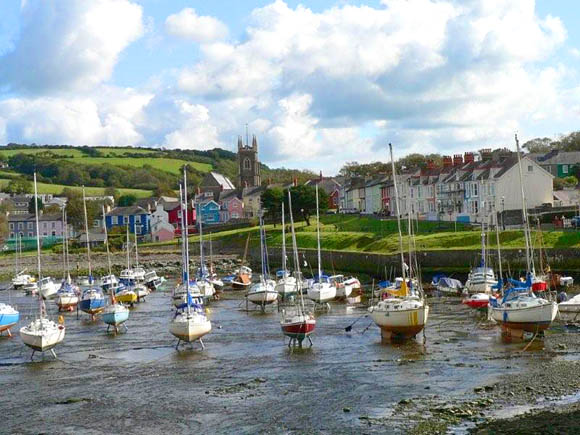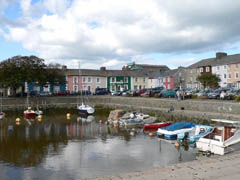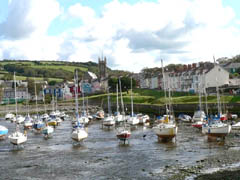Aberaeron, or Aberayron - From 'A Topographical Dictionary of Wales' (1849)
ABERAERON, or ABERAYRON (ABERAERON), a sea-port, and rising watering-place, partly in the parish of H�nvynyw, but principally in that of Llandewy-Aberarth, lower division of the hundred of Ilar, county of Cardigan, South Wales, 16 miles (S. W. by S.) from Aberystwith, and 23 (E. N. E.) from Cardigan; containing 534 inhabitants. The village is agreeably situated on the road from Cardigan to Aberystwith, at the lower extremity of the Vale of A�ron, the sides of which are in this part abrupt, and clothed with wood; and on the shore of Cardigan bay, at the influx of the river A�ron. This river here separates the parishes of H�nvynyw and Llandewy-Aberarth, and, with some springs in the neighbourhood, affords the inhabitants an ample supply of water; it is noted for trout and salmon, and there are several corn-mills on its banks. Abera�ron is indebted for its origin to the late Rev. Alban Thomas Jones Gwynne, of Ty-Glyn, who, in 1807, obtained an act of parliament, under the authority of which he built two piers at the mouth of the river A�ron, with convenient wharfs, cranes, and storehouses, at an expense of about �6000. The pier on the west was one hundred yards in length, and the other ninety, and both were built of stone; but, from the very exposed situation of the place, they were insufficient to afford adequate protection to vessels from the violence of north-westerly winds. To remove this inconvenience, it was necessary for the present proprietor, Colonel Gwynne, to extend the western pier about one hundred yards, inclining in a northern direction; which has been effected. The scenery of the Vale of A�ron is particularly beautiful, and, together with the marine atmosphere of the village, its retired situation, and improving condition, may render this, at no distant period, a place of very considerable resort during summer. Upwards of thirty new leases were granted some years ago, pursuant to which a number of houses have been built: a post-office, and an excellent posting-house and hotel, have also been established, the latter affording to families an equal degree of comfort and privacy to any inns in the principality. In 1835 an act was obtained for making and maintaining a road from New-Quay to this place.
The port is a member of that of Aberystwith, and is in a thriving state. There are from thirty to forty sloops belonging to it, of from seventeen to one hundred tons' burthen, which are navigated by about 120 seamen: they are chiefly employed in the importation of coal and culm, and two of them trade regularly with Bristol. The principal articles of importation, in addition, are grocery and timber; and of exportation, butter and oats: there is also a lucrative herring fishery, in which about thirty boats, with seven men to each, are engaged. Near the entrance into the harbour is a bar, which is dry at low water. The merchants' stores are open weekly, on Wednesday, for the reception of corn; and markets for provisions, &c., are now held every Wednesday and Saturday, under the auspices of Colonel Gwynne, proprietor of the manor: a fair for hiring servants takes place on Nov. 13th. All the quarter-sessions of the county are held here, and there are petty-sessions once a month, for the whole of the Abera�ron poor-law union: one of the county debt-courts established in 1847 is also fixed here, with jurisdiction over the union; and courts leet for the manor are held in May and October. There are places of worship for dissenters, and several schools. The poor-law union of which this place is the head, comprehends the fourteen parishes and townships of Ciliau-A�ron, Cydplwyv, Dihewyd, H�nvynyw, Kilkennin, Llanarth, Llanbadarn-Tr�veglwys, Llandewy-Aberarth, Llandysilio-Gogo, Llanerchaeron, Llanina, Llanllwchairn, Llansantfraid with Llanon, and Llanvihangel-Ystrad. It is under the superintendence of sixteen guardians, and contains a population of upwards of 12,874.
Mynach-dy, the property and residence of Col. Gwynne, situated at a short distance from the village, is supposed, from its name, which signifies "monastery," to have been anciently a small ecclesiastical establishment: in the grounds are some tumuli, called H�n Gastell, of obscure origin. On the sea-shore, near the village, is a circular encampment, designated Castell Cadwgan, and supposed to have been constructed by Cadwgan ab Bleddyn, about 1148. |









